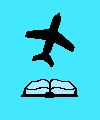 Return to
Return toAviation Answer-Man
Gateway
 Return to
Return to
Aviation Answer-Man
Gateway
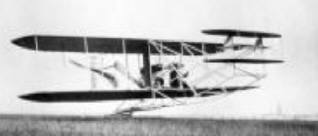 Return to
Return toCessna Aircraft
History of the Maker
of the
World's Most Popular Airplanes
Copyright 2002, 2003, 2004
from
articles by Richard Harris
appearing in InFlightUSA
Sept.-Dec., 2002 and Mar.-Apr. 2003
This month, as Cessna Aircraft Company (one of the world's oldest airplane manufacturers) continues its 75th year in business, we explore the growth and history of Cessna -- maker of far more light aircraft than any other in the world -- over 180,000 so far, serving in almost every imaginable capacity, from workplanes to warplanes, stuntplanes to bizjets, on every inhabited continent. And it started with a farm boy...
~~~~~
Barnstorming and Pioneering: Cessna
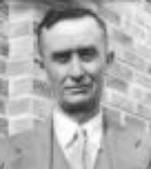 Clyde Cessna, a Kansas farm boy in the
1880's, became a consummate handyman and mechanic, helping
Rago-area farmers with their machinery. His skills lead to a
successful early career with automobiles -- first as mechanic,
then as super-salesman in nearby Enid, Oklahoma. By 1911, Clyde
had saved over $7,500 (over ten years' wages in 1911 money). But
at an aerial exhibiton in Oklahoma City, he saw the primitive
"flying circus" of John B. Moisant, earning thousands
of dollars with brief aerial exhibitions. Believing he could do
that, too, Cessna dove into a fascination with airplanes. He set
his mind to building a copy of the French Bleriot
monoplane which had most fascinated him in the show. Clyde
jumped a train to New York City, and worked for a month at the
short-lived Queen's Aeroplane Co, which built a
handful of Bleriot "knock-offs." Clyde learned the
craft of plane-building, and took home a fuselage, around which
he built a complete working plane.
Clyde Cessna, a Kansas farm boy in the
1880's, became a consummate handyman and mechanic, helping
Rago-area farmers with their machinery. His skills lead to a
successful early career with automobiles -- first as mechanic,
then as super-salesman in nearby Enid, Oklahoma. By 1911, Clyde
had saved over $7,500 (over ten years' wages in 1911 money). But
at an aerial exhibiton in Oklahoma City, he saw the primitive
"flying circus" of John B. Moisant, earning thousands
of dollars with brief aerial exhibitions. Believing he could do
that, too, Cessna dove into a fascination with airplanes. He set
his mind to building a copy of the French Bleriot
monoplane which had most fascinated him in the show. Clyde
jumped a train to New York City, and worked for a month at the
short-lived Queen's Aeroplane Co, which built a
handful of Bleriot "knock-offs." Clyde learned the
craft of plane-building, and took home a fuselage, around which
he built a complete working plane.
 Through crashes and injuries (including leaping from
an inverted plane before it crashed, and weeks in the hospital),
determined Cessna mastered the beast, and began flying
exhibitions profitably. Along the way, though, he came near
bankruptcy -- moving his family back to family farmland in Rago,
where the sole structure was a barn. His tolerant wife raised the
kids in the hayloft, while Clyde worked through the winters' cold
to rebuild his tattered machine into a better bird. It emerged
next spring with silver-painted wings, and greater capabilities
than ever before. Though he toured county fairs and sports
events, and even made special visits of his own throughout the
heartland, Clyde was never able to make the thousand-dollar
flights of earlier pioneers. Nevertheless -- in a day when most
folks only earned about $600 a year -- Clyde was making hundreds
of dollars per flight in his "Silverwings."
Through crashes and injuries (including leaping from
an inverted plane before it crashed, and weeks in the hospital),
determined Cessna mastered the beast, and began flying
exhibitions profitably. Along the way, though, he came near
bankruptcy -- moving his family back to family farmland in Rago,
where the sole structure was a barn. His tolerant wife raised the
kids in the hayloft, while Clyde worked through the winters' cold
to rebuild his tattered machine into a better bird. It emerged
next spring with silver-painted wings, and greater capabilities
than ever before. Though he toured county fairs and sports
events, and even made special visits of his own throughout the
heartland, Clyde was never able to make the thousand-dollar
flights of earlier pioneers. Nevertheless -- in a day when most
folks only earned about $600 a year -- Clyde was making hundreds
of dollars per flight in his "Silverwings."
Every year, he built an improved version of the previous year's plane. By 1916, he was invited to build his personal show planes in Wichita's "Jones Six" auto factory (for publicity), and he accepted. His 1916 "Jones Six" (looking similar to today's popular Eipper Quicksilver ultralight) had the car-maker's name painted under its wings in giant letters, visible from a thousand feet below. It was the first airplane built in Wichita -- the first of over a quarter-million which would eventually come from Wichita, ultimately making this "Air Capital City" the birthplace of more airplanes than any other city on Earth. (The old Jones Six factory -- better known from railroading years by its original name, "Burton Car Works" -- would later give birth to airplane manufacturers named Stearman, Culver and Mooney.)
And it was here that Clyde crafted his speedy "Comet." (a name he would re-use on subsequent planes). Looking like the Silverwings, it was distinguished by a fully-covered fuselage, and a windshield-like fairing bowl over the front of the cockpit. In 1917 -- flying from Blackwell, Oklahoma to Wichita (perhaps riding the area's famed south wind), the Comet set the U.S. national speed record of 124-mph.
Clyde had begun selling lessons, and started trying to build planes to sell, when the U.S. entered World War I, in 1917. The government canceled all flying exhibitions and races, and other civilian aviation, to divert resources to war. The government ignored Cessna's offer to build trainers and train pilots for the war, so Clyde returned to Rago -- and farming.
The Barnstormer/Farmer becomes an Airplane Manufacturer
World War I had excluded Clyde Cessna, so he'd returned to his Rago farm, and developed a profitable grain-threshing business, and was soon quite well off. But aviation was still an itching passion for him. He spent a chunk of his money buying a Swallow airplane from America's first successful commercial airplane-manufacturing company, the E. M. Laird Manufacturing Co., in neighboring Wichita.
 Returning to Wichita, in 1926, Clyde invested his
profits to join former Swallow workers Walter Beech and Lloyd Stearman in starting Travel
Air Manufacturing Company -- which would soon become the world's leading producer
of civilian aircraft. (Stearman -- a young man recently schooled
in architectural engineering and as a Navy airplane-rigger and
student pilot -- was from Harper, near Rago. The first plane he'd
ever seen aloft was Clyde's 1916 "Jones Six.")
Returning to Wichita, in 1926, Clyde invested his
profits to join former Swallow workers Walter Beech and Lloyd Stearman in starting Travel
Air Manufacturing Company -- which would soon become the world's leading producer
of civilian aircraft. (Stearman -- a young man recently schooled
in architectural engineering and as a Navy airplane-rigger and
student pilot -- was from Harper, near Rago. The first plane he'd
ever seen aloft was Clyde's 1916 "Jones Six.")
While Beech and Stearman preferred to develop stout, open-cockpit biplanes, Cessna preferred efficient, enclosed-cabin monoplanes. His swift, heavy-hauling, 5-seat Travel Air Model 5000 became the first airliner built to an airline's specifications, and even Charles Lindbergh had wanted one for his now-famous New-York-to-Paris flight (Walter Beech turned him down). It became famous for other racing and endurance flights however, including the first flight to Hawaii.
Cessna Aircraft Co. takes off -- into turbulence
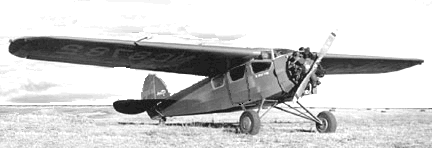
Leaving biplane-builder Beech behind (Stearman had already struck off on his own), Clyde started Cessna Aircraft Company in 1927 -- to build one of America's very first cantilever-wing monoplanes (with no external bracing, depending on the strength of its carefully-crafted, stout, internal wing structure). The 3-4 seat Cessna "A" Model -- able to drag a half-ton load at over 100mph on just 110hp -- was soon winning major races, becoming respected and popular. Cessna had little trouble getting orders for the plane. (The first one was delivered to budding flight instructor Edwin Link -- inventor of the flight simulator).
It seemed reasonable to expect that there would be plenty of customers for the acclaimed "A" Model. But a lot of money was needed "up front" to build up production capacity fast enough to meet the sudden, fleeting demand expected for the $7,000 airplanes.
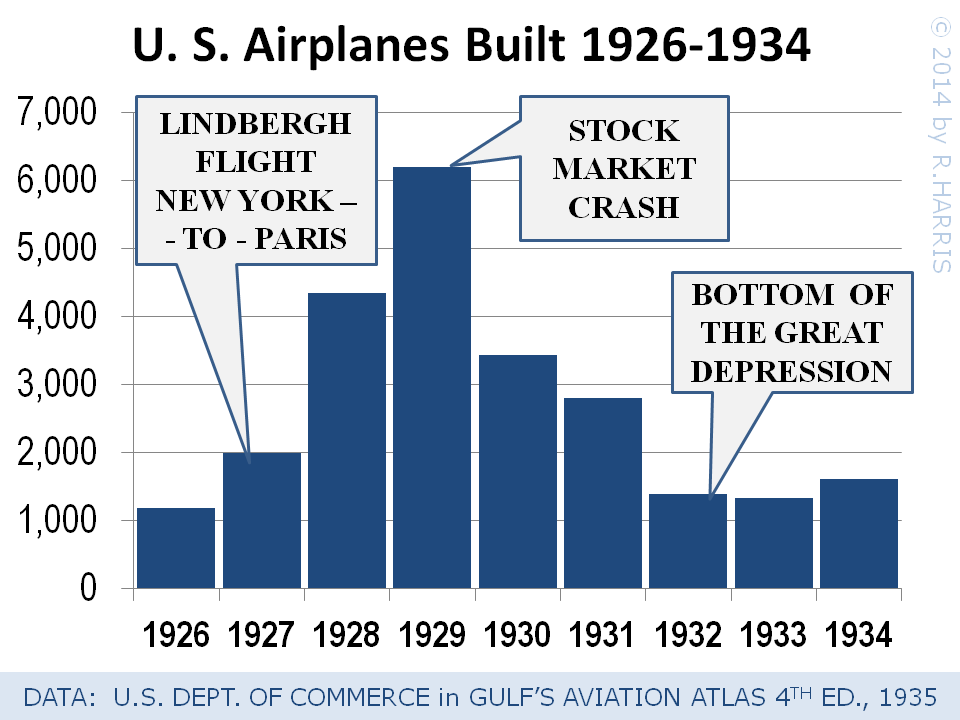 Clyde decided to take
the risk, and forfeited controlling interest in Cessna Aircraft
Co. -- in exchange for investment money to build up his company's
manufacturing capacity.
Clyde decided to take
the risk, and forfeited controlling interest in Cessna Aircraft
Co. -- in exchange for investment money to build up his company's
manufacturing capacity.
Unfortunately, he did so just as the Great Depression struck, wiping out the market for airplanes.
Despite resorting to selling cheap, popular gliders, Clyde was unable to keep up sales, and was voted down by his company's new board of directors, who halted production.
Unlike most other airplane companies of the day -- which were either acquired by the parent companies of their engine-makers, or were driven into bankruptcy, Cessna Aircraft Company remained technically solvent -- but ceased operations, closing the factory doors, and sending everyone away, including Clyde Cessna, himself.

|
|
| World's fastest racer in the under-500-hp class, Cessna's rocket-like CR-3 won every race it entered -- dozens -- until it crashed. See the full, dramatic racing history of Cessna's CR-series at the "Air Racing History" website, at: www.airracinghistory.freeola.com . |
All in The Family
During the early, severe years of the Great Depression, Clyde (with his aeronautical-engineer son, Eldon) built custom race planes -- in a corner of the shuttered Travel Air factory (last run by Walter Beech). Clyde's CR-3, America's hottest raceplane in the under-500-horsepower class, won every race it entered.
But the CR-3's predecessor, Clyde's CR-2 raceplane, would bring him terrible sadness. Someone else, tweaking the plane for more speed, had modified CR-2's engine cowling -- badly. And September 2, 1933, during the International Air Races in Chicago, the cowling tore off at over 200mph, striking the wing hard enough to tear it off -- flinging the plane into the ground in front of Clyde, killing famed race pilot, Roy Liggett -- Clyde's buddy. The violent tragedy would torment Clyde forever, robbing him of much of his enthusiasm for aviation.
Back at the factory, though, Clyde and Eldon -- struggling to keep the company alive -- developed from the A Model a larger, stronger, 170-300 horsepower plane, the DC-6a and DC-6b, capable of hauling the heavier, well-fed, "fat-cat" executives who financially and physically survived the ravages of the Great Depression. From that design, they also did a "one-off" of Clyde's last design, the C-3, a streamlined version of his DC-6, using a "NACA" cowling around a 125-hp Warner radial. It would foreshadow the Airmaster line.
Meanwhile, Walter Beech quit Curtiss-Wright's relocated Travel Air Division, to develop his own Model 17 Staggerwing biplane. Returning to Wichita to open Beech Aircraft Company, he was unable to rent back his old Travel Air factory, so Beech rented space in a corner of Cessna's closed factory. The irony went a bit further when Dwayne Wallace, Cessna's nephew (who'd been taught to fly by his Uncle Clyde), graduated from Wichita University's new aeronautical engineering program, and went to work for Walter Beech -- in Uncle Clyde's old factory!
The paradox was too strange to stand. Dwayne Wallace, and Dwayne's lawyer-brother Dwight, approached their uncle Clyde, and encouraged him to battle to retake control of his company. The Wallace brothers toured the country talking to Cessna Aircraft's main stockholders, and offered that they and their uncle would work for free until the company was profitable, if given a chance to run it again, and put Cessna airplanes back in production. It was a close battle, but the Wallace brothers won the day, and Uncle Clyde returned to the presidency of his namesake.
But Clyde's return to his company was largely symbolic. The Wallace Brothers were really the driving force in its revival. Clyde retired in 1936. Having had enough of aviation, he returned to his farm for good, never to bother with airplanes again.
Setting
the Pace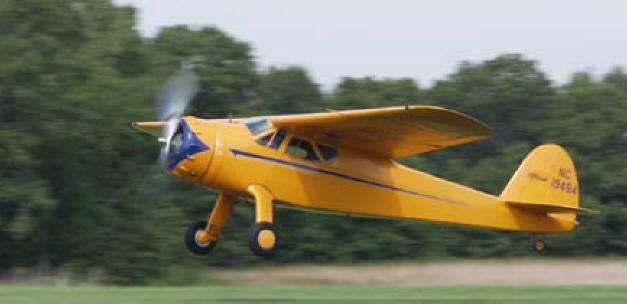
The history is murky here, but some claim that Cessna's son, Eldon was the key designer on the next important Cessna design -- but more seem to credit Dwayne Wallace. Either way, between them, the C-34 -- first of Cessna's defining Airmaster family -- emerged from the reconstituted airplane-maker. This clean, high-winged four-seater -- with a strutless "cantilever" wing and Cessna's first flaps -- was a marvel of efficiency for the times, reaching 165mph on just 145 horsepower (pretty impressive even by today's standards). In its horsepower-and-size class, it was nearly impossible to beat, and commonly won the races in its class.
Dwayne Wallace not only ran the factory, and test-flew the planes, he raced them. Among the races was the Detroit News Trophy for "The World's Most Efficient Airplane" -- a long-distance race, testing horsepower-to-speed performance, in a series of long flights. Uncle Clyde's Model AW had won the race in 1931, before it was suspended because of the Depression. When the race was resurrected in 1935, Cessna test pilot George Harte, with Wallace, won the race. And again in 1936, a Cessna seized the trophy. By the tradition of the times, winning an annual trophy in three times in a row entitled the triple-winner to keep the trophy permanently. It was retired to to Cessna, and the C-34 was "officially" designated "The World's Most Efficient Airplane."
Racing victories brought glory, glamour and gold to Cessna. Nothing so proved the capabilities, practicality and worth of an airplane like a public competition witnessed by thousands. And nothing spread the word better. Victories turned into sales. And -- just as importantly at times -- the trophy money helped pay salaries at the struggling company. Though Uncle Clyde had his savings, and Dwight Wallace had his law practice, Dwayne apparently had no other regular source of income. Having promised to work at Cessna for free, one wonders where he got the money to eat. He took on a very gaunt, hungry look in those early years. But he stayed on the job. Workers noted, too, that he wasn't above carrying water or sweeping floors, when the work needed doing.
Progress
Wallace's persistence would pay off. Slowly, as the nation crawled out of the Great Depression, sales rose. And Wallace rose to meet the opportunities the future seemed to hold, pushing Cessna out of its comfort zone, into developing a muscular little twin-engined plane.
The new Cessna T-50 Bobcat -- a slight wood-and-metal framed, fabric-covered, 5-seater -- was a surprisingly practical and capable airplane for the money. Powered by twin 225-hp Jacob radials, it reached cruise speeds nearing 200mph. Wallace had envisioned it as a sort-of short-haul mini-airliner and charter air-taxi plane (in these days, few people flew, but those who did had the money to support an expensive ticket; 3-4 passengers could make a flight profitable in a light plane). With a basic price tag somewhere around $25,000 (a little over $300,000 in today's money), it was a plane with potential.
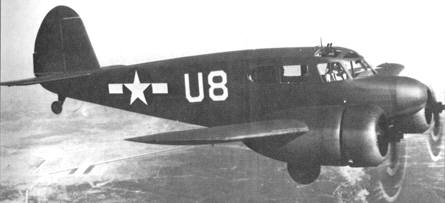 Test-flight Tales
Test-flight Tales
In the process of test flying it, Wallace became the company's first "multi-engine" pilot. (Later, when Wallace took the plane to Kansas City for its certification check flight with the federal flight inspector, Wallace reportedly startled the inspector afterwards, by asking the inspector to also certify him -- as a new multiengine pilot.) Wallace's right-hand man, Cessna factory manager Bill Snook (of Swallow and Travel Air fame), had been pressured by Mrs. Snook to give up flying (in those days, lightplane aviation was even far more hazardous than it is today, and aviator fatalities were all-too-common.). But Snook couldn't resist the chance to ride along for what would apparently be the first flight of Cessna's first "big" airplane (according to a tale told by his children at Snook's induction into the Kansas Aviation Hall of Fame, in 2003). Mrs. Snook, had stopped with her children to watch the new prototype land at the airfield, unaware that Mr. Snook was aboard -- but saw her husband emerge... leading to language which her children were still reluctant to describe in detail, over half a century later.
War brings Wealth
With World War II approaching -- already aflame in Europe and the Pacific -- U.S. military services began gearing up for the inevitable involvement, and America was already supplying arms to Great Britain and her empire, including Canada. Wallace had found some military interest in his new twin as a trainer for transport and bomber pilots, and as a medium-range light transport. And in June 1940, the Army Air Corps (this was before the U.S. had an Air Force) placed an order for 33 Bobcats. While that seems a pittance today, it was -- at the time -- the biggest single order in Cessna's history.
But the most immediate interest came from Canada, already sending troops to fight in Europe. With a deal struck, the Bobcat was relabeled the Crane, and sent to help Canada defend the British Empire. Canada had ordered 140 Cranes -- the biggest plane-order in the history of the "Air Capital City" (as Wichita was known). To convince the Canadian and British authorities that Cessna was up to the job, Wichita's leading local banker had to guarantee to loan Cessna all the money necessary to immediately build up the company, and the airplanes, to meet the urgent order. But the deal went through.
Shortly thereafter, the U.S. government ordered thousands of these planes, with bigger 290-hp engines, to train pilots. Most of the transport and bomber pilots of World War II -- flying "Gooney Birds," B-25's, B-24's, B-17's and B-29's and other heavy iron -- would first learn their multiengine skills in a Cessna "AT-8" (for "Advanced Trainer") Bobcat. Over the course of the war, 700 more -- labeled as "Cranes" -- would head to Canada, and another 4,700-plus Bobcats would enter U.S. military service. Many would serve as "UC-78" (for "Utility Cargo") light transports -- shuttling military brass and supplies.
The Bobcat spurred rapid growth at Cessna, as employment shot up from 200 workers to over 2,000 in the first year of the Bobcat contracts. An additional factory was hastily built. The money came rolling in. And Wallace (it seems, in photos of the time) began to look a little less scrawny.
The Bobcat had been chosen partly because it was a plane that used precious little "strategic materials" -- like aluminum, magnesium, and steel -- which the federal War Production Board tried to reserve for combat aircraft and other weaponry. (Its largely-wood construction earned it the unofficial military nickname "Bamboo Bomber.")
 Cessna's experience with this type of
construction led to its being picked among the half-dozen or so
sub-contractors assigned the task of building large, disposable,
wood-and-fabric "invasion gliders." Towed behind
transports and bombers, these WACO CG-4
Hadrian combat gliders, were huge -- able to carry
a dozen armed troops, or a jeep, or a howitzer and its ammunition
-- over combat zones, where they would be released for their
one-and-only landing, usually behind enemy lines, during
invasions. Cessna would be commissioned to build 750 of them over
the course of the war.
Cessna's experience with this type of
construction led to its being picked among the half-dozen or so
sub-contractors assigned the task of building large, disposable,
wood-and-fabric "invasion gliders." Towed behind
transports and bombers, these WACO CG-4
Hadrian combat gliders, were huge -- able to carry
a dozen armed troops, or a jeep, or a howitzer and its ammunition
-- over combat zones, where they would be released for their
one-and-only landing, usually behind enemy lines, during
invasions. Cessna would be commissioned to build 750 of them over
the course of the war.
But that left Cessna tooling up for old-fashioned tube-and-fabric design, while companies producing combat aircraft were working in futuristic materials and designs -- particularly durable, lightweight, aluminium-shell ("semi-monocoque") modern aircraft. Cessna, though would get a chance to work in aluminum. Cessna landed contracts to make major parts of B-26 and B-29 bombers (typically wings and tails). The govenrment war-production orders provided the backing to equip and train the Cessna Aircraft Co. to work in modern aluminium aircraft manufacturing. This was arguably the single most pivotal advantage Cessna ever acquired in getting a leg up on other major lightplane makers, like WACO, Piper and Stinson.
Peacetime
Peacetime brought a collapse of the military aviation industry. But the industry was convinced that returning soldiers would buy their own light planes, by the hundreds of thousands, soon after the war. So the light plane makers -- already tooled up for mass production -- started a rash program of sales, taking orders at the drop of a hat, with little or no deposit. In 1946, over 30,000 new light planes were built -- probably more than in all of the war years. Then the government dumped 30,000 war-surplus military puddle-jumpers on the market. The manufacturers who had built them -- Aeronca, Piper, Interstate, Porterfield, Taylorcraft, Luscombe, Funk, Rearwin and Stinson -- were mostly wiped out by competition from their own wartime products, sold as bargain war-surplus planes. Those that remained were severely crippled. By the beginning of 1948, the Boom and Bust had turned into the Great Shakeout.

|
| Cessna 195 -- originally this plane was the personal mount of Cessna leader Dwane Wallace. Shown here during the 2007 International 195 Association Fly-In, taking off from Stearman Field, near Wichita, with 99-year-old former Cessna 195 test pilot Mort Brown in the pilot's seat, with his co-pilot, the plane's new owner, Cessna CEO Jack Pelton, in right seat. For more on this event, click here. |
But Cessna stayed in the game. It continued with a few military airplane sub-contracting jobs, building parts of the Fairchild Flying Boxcar transport and Ryan Fireball fighter. But Wallace took his company's new expertise in modern aluminium-shell construction and produced a whole, new airplane -- an incredibly sleek, all-metal version of the Airmaster -- the 6-seat Model 190, and its more muscular version, the 195. The plane had fierce speed for a single-engine light plane of the times (over 165mph with a 300-horse Jacobs radial engine) and carried substantial loads, seating five. And the roomy 190/195 had Cessna's newest trademark feature: spring steel landing gear.
Thanks to inventor race pilot Steve Wittman, the Model 190/195 was equipped with the simplest, and best, landing gear of the times: a simple one-piece curved bar of spring steel, arcing from wheel to wheel -- through the fuselage. Though it made for bouncy landings, it was far less bulky and complex than the "bungee-cord" shock-absorbers on other lightplane landing gear of the times -- which also bounced. Even the few planes with modern, automotive-style, "oleo" (air-oil compression) shock-absorbers had much bulkier landing gear, with greater drag. The clean, simple, trouble-free "spring-steel" gear design -- a hallmark on single-engine Cessnas to this day -- could survive incredible abuse, and simplified aircraft maintenance, while providing far less drag than most other landing-gear designs of the time.
Start of the Strut-Wing Series
But the real market lay in small, inexpensive airplanes for personal use and training. Enter the Cessna 120/140.
The main plane was the 140. The 120 was a stripped-down
version, without the extra side windows, wing flaps, nor an electric system
(battery/starter/generator). You had to hand-prop a 120 to start
it (not too hard with its little 80-90 hp engine). A lightweight
two-seat taildragger, the 120/140 was fundamentally different
from most of the other two seaters which came before it: It
was all-aluminum (though, in the earliest models, wings were fabric-covered).
The 120 was a stripped-down
version, without the extra side windows, wing flaps, nor an electric system
(battery/starter/generator). You had to hand-prop a 120 to start
it (not too hard with its little 80-90 hp engine). A lightweight
two-seat taildragger, the 120/140 was fundamentally different
from most of the other two seaters which came before it: It
was all-aluminum (though, in the earliest models, wings were fabric-covered).
But the 120/140 conspicuously departed from Cessna tradition to share one thing in common with its old-fashioned competitors: wing struts. A pair of clean, simple wing struts held up the wings of the 120, allowing for a smaller main wing spar passing overhead, allowing much more head room in the plane than would otherwise be possible (raising the wing for more headroom would have increased the airplane's frontal area, and drag)
The 120/140's all-aluminium construction was expected to simplify and reduce maintenance costs, while making for a sleeker, more efficient airplane. Comparable in many ways to the sleek, pre-war Luscombe 8, Cessna's 120 had advantages over even that snappy plane. The 120 had the spring-steel gear, which delighted training schools who hated fixing complex, delicate gear systems on other planes after the inevitable abuse from a few hundreds hours of training flights. The plane was also a bit roomier, with slightly better visibility. And it was cheaper, thanks to Cessna's war-funded tooling and training for aluminum-shell manufacturing.
This
was the plane that would make Cessna a juggernaut in
light-airplane manufacturing -- seizing from Piper the crown of
"#1 Lightplane Maker."
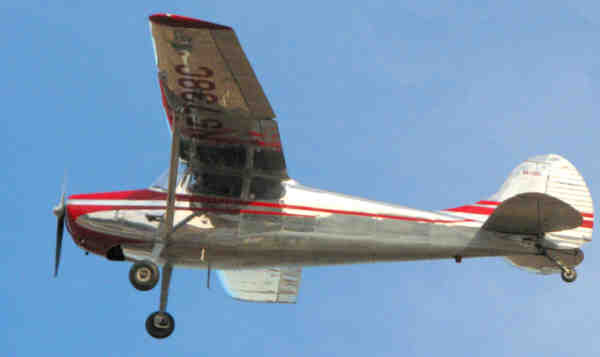
Battling for #1
Piper countered the sleek, popular 120/140 with various stretched and expanded Piper Cubs -- Cub Cruiser, Family Cruiser, Pacer -- hauling 3 to 4 folks, at cheap-plane prices. Cessna countered by stretching the 120/140 into the 4-seat Cessna 170, which again took over the market for 4-seaters in the exact same way as the 120/140 had for 2-seaters.
With only 145 horses, the 170 was really more like a 3-seater, if the tanks were full -- like Piper's prize 4-seater, the Pacer -- limiting its utility. But the plane nevertheless offered a wide range of practical uses, from short-haul 4-seater, to medium-range 3-seater, to long-range (about 600 miles) single-seater, at respectable cruise speeds for the times (100-120 mph). And compared to the Pacer, it was roomy and comfortable, with the style and durability of all-metal construction -- and it was a easier-handling airplane, on the ground and aloft.
Though both Aeronca and Luscombe fielded noteworthy competitors (both named "Sedan"), each were a good 10-20 mph slower than the 170, while using the same engine, and lacked the support of Cessna's rapidly growing dealer network -- reinforced by the popular 120/140, which was rapidly becoming the preferred trainer for new pilots. As Piper and Aeronca had learned earlier, the brand of trainer that a new pilot learned in -- whether Piper Cub or Aeronca Champ or Cessna 120/140 -- was often an important influence on what brand of airplane they would buy later.
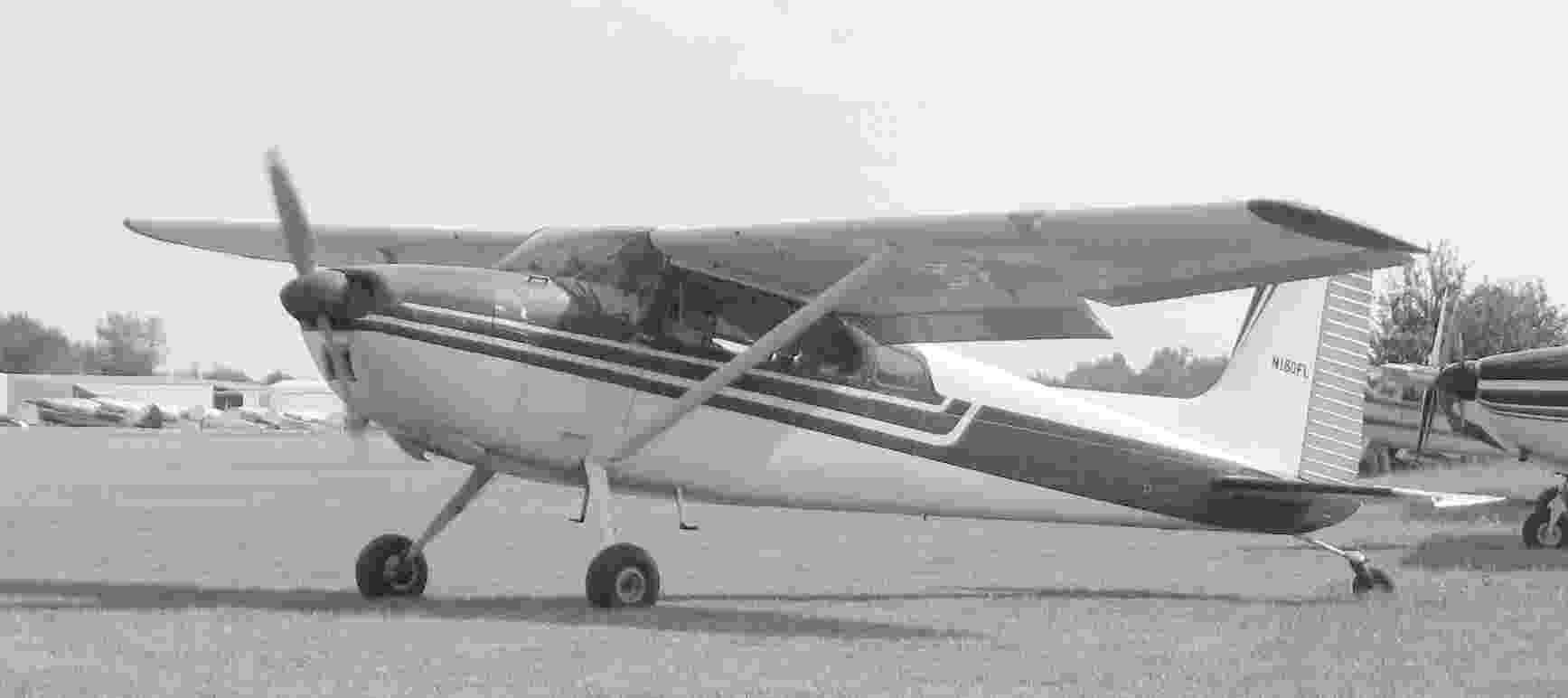
Huge "slotted Fowler" wing flaps that could be lowered to allow very slow flight, were fitted to the wings of the 180, and retro-fitted to the 170 (as the Cessna 170B), enabling slow, steep descents, and casual, precision landing -- making Cessnas the easiest-landing 4-seat planes on the market, and significantly safer than most of their competition. These "Para-Lift" flaps would become another key Cessna sales advantage, continued on most Cessna planes to this day.
The
flaps had another purpose -- design of a military "liaison
aircraft" to replace all those tired tube-and-fabric
puddle-jumpers which had been used to such great effect in World
War II. The military wanted a plane capable of very slow flight
(for aerial reconnaisance, and for landing in tiny places near
combat areas) without the antiquated construction of the rag-wing
planes.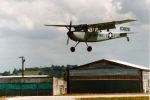 The 170 was modified into a 2-seater -
the L-19 (later "O-1")
Bird Dog -- with enough interior space
for a wounded soldier on a cot, or an observer, while providing
enough horsepower and lift to get out of the tiniest spots,
enough speed and range to make lengthy flights quickly, and a new
"greenhouse cockpit" wrapped in windows for superior
reconnaisance visibility. Beating out other lightplane makers in
a military competition, Cessna found itself back on the war-wagon
gravy-train, enjoying the security (and creditworthiness) of a
long backlog of guaranteed government orders.
The 170 was modified into a 2-seater -
the L-19 (later "O-1")
Bird Dog -- with enough interior space
for a wounded soldier on a cot, or an observer, while providing
enough horsepower and lift to get out of the tiniest spots,
enough speed and range to make lengthy flights quickly, and a new
"greenhouse cockpit" wrapped in windows for superior
reconnaisance visibility. Beating out other lightplane makers in
a military competition, Cessna found itself back on the war-wagon
gravy-train, enjoying the security (and creditworthiness) of a
long backlog of guaranteed government orders.
The extensive parts-commonality with the 170 and 120 gave Cessna an economy-of-scale that was almost impossible to compete with -- unless Piper could come up with a plane that sold by the thousands upon thousands.
Tricycle Trouncing
Piper
countered with its tricycle-geared Piper Tri-Pacer
-- much easier plane to land, if landed on the
rapidly-growing number of smooth, paved airstrips popping up
everwhere. Suddenly, the airplane seemed "as easy to fly as
a car is to drive" -- and that was the way it was
advertised. The Piper trike was spectacular success -- selling
over 7,600 copies in under 10 years, dwarfing the sales of its
other 4-seaters -- and Cessna's -- combined. 
For a strangely long time, Cessna didn't respond (around this time Cessna was absorbed in the military contracts, and in developing a modern, aluminum-shell light twin). But in 1956, Cessna put a nosewheel on the 170. The resulting 172/Skyhawk soon clobbered the boxy, tube-and-fabric Tri-Pacer -- and eventually outsold EVERY other light airplane -- in the WORLD!
To
this day, the Cessna 172/Skyhawk remains the most
widely-circulated, most mass-produced light plane in history,
with over 30,000 built, most still flying, throughout the globe.
Despite Cessna's curtailment of production in 1986, the line was
revived in 1992, and is going strong today. To a large extent, the Cessna 172/Skyhawk is widely regarded as THE defining airplane of personal aviation, worldwide.
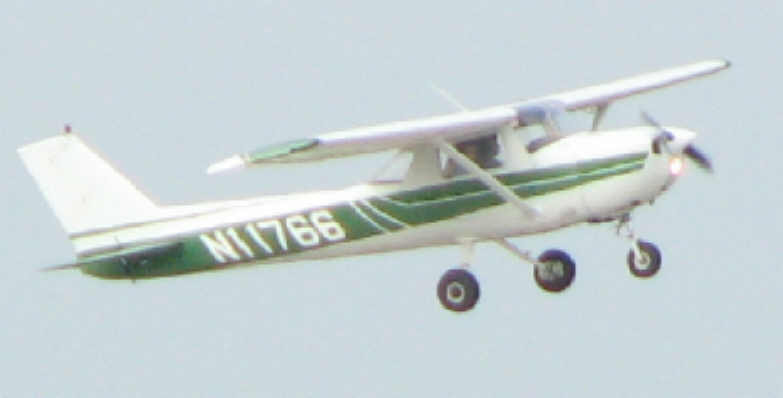
From the 172, with influences from the 120/140, Cessna created a "chopped-down" two-seater: the Cessna 150, which would become the first trainer to completely unseat the King of Trainers: the Piper Cub. By comparison to the Cub (and others like it), Cessna's 150 -- with its nosewheel, spring-steel main gear, Para-Lift flaps, side-by-side seating, and modern aluminum-shell design -- was a far more appealing trainer to novice students (and their instructors) than the awkward, taildragging, tandem two-seaters of Piper, Aeronca, and others. Its tricycle gear made it far more appealing to novice pilots than even Cessna's own otherwise-similar 120/140 taildraggers. And flight schools loved its relative safety, simplicity, and durability.
With cruise speeds surpassing 110 mph (compared to the Cub's 80 mph), the 150 brought a whole new level of range, expedience and versatility to cross-country training flights. And unlike its elderly competitors, it had room in the instrument panel for the full range of modern instruments and radios. Yet the 150 retained enough of the handling challenges of its predecessors to ensure a thorough learning experience for new pilots, preparing them for a wide range of future aircraft.
The 150 would sell over 10,000 copies (a few as the acrobatic Aerobat, and many as the slightly higher-powered 152) before its discontinuance in the 1980s. (A slightly larger, slightly-more-powerful version, the 152, would replace it.) Even today, the 150/152, though discontinued, is the most widely used trainer for basic pilot instruction. Its chief competition among trainers is its own big brother, the still-in-production Cessna 172/Skyhawk, now widely used in its place.
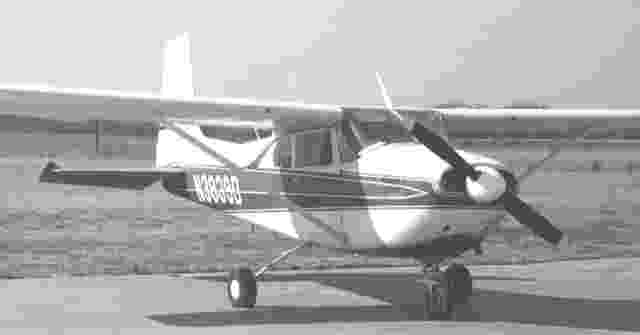 And once pilots learned in a Cessna, they were
likely to prefer Cessnas for future flying, as well -- renting or
buying 172s, and their successors, the muscular 182/Skylane
(shown at left, the tricycle-geared plane derived from the 180, it became the world's most popular "high-performance" single), and
the high-powered 5-6-seat Skywagon 206 (below, right),
which quickly became the most desired utility plane in the world.
And once pilots learned in a Cessna, they were
likely to prefer Cessnas for future flying, as well -- renting or
buying 172s, and their successors, the muscular 182/Skylane
(shown at left, the tricycle-geared plane derived from the 180, it became the world's most popular "high-performance" single), and
the high-powered 5-6-seat Skywagon 206 (below, right),
which quickly became the most desired utility plane in the world.
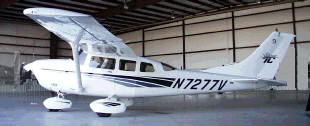
A taildragger version of these planes became the strong, swift, 300-horse Skywagon 185 -- soon the world's most popular heavy-duty bush plane.
Cessna's strut-wing singles were offered in countless variations, some with different model numbers. (on pontoon floats, they became the world's most popular seaplanes). Militaries around the world ordered them for countless missions, as did countless commerical flying services and start-up airlines. (For example, Wichita-based Air Midwest -- officially the nation's first "certificated commuter airline" -- started with a single 206, hauling caskets -- and quckly grew into the eighth largest commuter airline in the United States, spanning the entire middle U.S. with big planes.)
And other planes
emerged from the strut-wing singles: low-wing
cropdusters (the AgWagon family) , a
tandem-engined twin (the Skymaster) and
others. Cessna returned to the sleek, strutless
"cantilever" wing for its high-performance retractable
single, the 210/Centurion, and its
little brother, the sleek 177/Cardinal
-- available with and without retractable gear.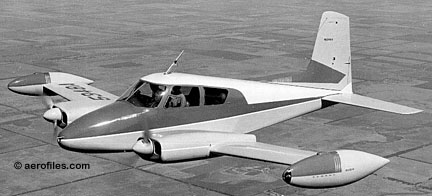
Arch-rival Piper Aircraft was completely outclassed, and Cessna became the world's biggest maker of light planes -- a role it held for over a quarter of a century.
Epilogue and Beyond
Cessna had also been developing a sleek, speedy, efficient light twin -- the Cessna 310 -- which would outsell and outlast most of its contemporaries. With over 220-mph speed, on modest lightplane engines, it was big hit with business flyers everywhere. A big sale to the Air Force (for a military version to taxi generals around) was a strong boost to the program, too. The military contracts led to the building of another big, new factory -- this time across town, at the new Wichita Municipal Airport, on Wichita's southwest side.
Cessna also took a gamble at building a jet
trainer for an Air Force contract. Despite no experience with
aircraft at jet speeds, and little experience with
high-performance military planes, Cessna won. 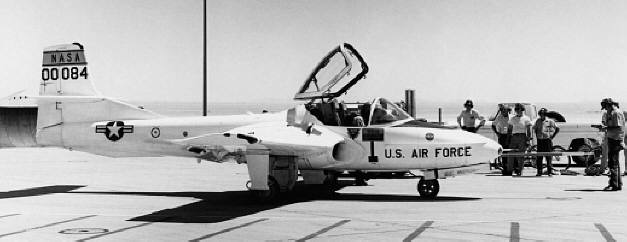 Their twin-jet T-37
trainer (colloquially known as "Tweety" for its
high-pitched engine whistling) became the standard first jet in an Air Force pilot's training regimen. Hundreds would be built for the Air
Force. Later models, as the A-37B Dragonfly,
would be fitted for ground attack, with bombs, rockets and
machineguns, and used in the Vietnam War as killing machines.
Subsequently, many have found their way into the air forces of
various nations too poor to operate any other jet aircraft, but
determined to have a capable jet weapon..
Their twin-jet T-37
trainer (colloquially known as "Tweety" for its
high-pitched engine whistling) became the standard first jet in an Air Force pilot's training regimen. Hundreds would be built for the Air
Force. Later models, as the A-37B Dragonfly,
would be fitted for ground attack, with bombs, rockets and
machineguns, and used in the Vietnam War as killing machines.
Subsequently, many have found their way into the air forces of
various nations too poor to operate any other jet aircraft, but
determined to have a capable jet weapon..
The Cessna 310 led to a string of bigger twins, including cabin-class and turboprop aircraft. Pressurized versions (like the 421 Golden Eagle and turboprop 441 Conquest) offered a Cadillac ride to executives, while unpressurzed models with lots of room (like the 402 and 404 Titan) became valued as compact, efficient commuter airliners and cargo ships.
The cargo plane idea would be carried even farther, with
Cessna's biggest cargo plane -- a giant strut-winged,
single-engine turboprop with fixed tricycle gear. Simply put,
nothing like it had ever seen popular production before. But an
order from the nation's leading air-express company, Federal
Express, for over a hundred of these handy, economical, reliable
cargo ships convinced Cessna to go out on the limb and try it.
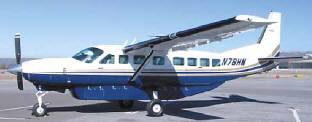
The 208/Caravan has been a spectacular success, and is now one of the most heavily worked light aircraft in the world -- with many hundreds hard at work day and night around the globe, at big city airports and remote jungle clearings. A stretch version -- hauling a dozen -- is popular. Another version, offered with floats, is the world's biggest floatplane currently in production. An optional belly pod (similar to pods offered on some Skywagons and Skymasters) adds to cargo space.
 The last great project over which Dwayne Wallace
presided was production of the low-and-slow, 400-mph Cessna
Citation business jet. It
would quickly unseat the sexy 500-mph Learjet (built
just on the opposite side of Wichita's Municipal Airport) as the
world's most popular bizjet. While the Lear had sex-appeal and
status, the much humbler Citations were much gentler planes, with
simpler landing characteristics, ability to get in and out of
smaller (and therefore more) airfields, and much better
fuel economy (using new "fan-jet" engines). The
Citations became the first bizjets to sell by the thousands.
The last great project over which Dwayne Wallace
presided was production of the low-and-slow, 400-mph Cessna
Citation business jet. It
would quickly unseat the sexy 500-mph Learjet (built
just on the opposite side of Wichita's Municipal Airport) as the
world's most popular bizjet. While the Lear had sex-appeal and
status, the much humbler Citations were much gentler planes, with
simpler landing characteristics, ability to get in and out of
smaller (and therefore more) airfields, and much better
fuel economy (using new "fan-jet" engines). The
Citations became the first bizjets to sell by the thousands.
Now well aged, Wallace retired to a life of liesure and local philanthropy with his wife, passing the baton to Russ Meyer. Meyer, a former Marine Corps fighter pilot and lawyer, had earned his general-aviation stripes reviving the troubled American Aviation Yankee of engineer/entreprenur Jim Bede. He stabilized the company, and nursed it through modifications to the Yankee which ameliorated the hot little 2-seater's troubling crash history, then oversaw the creation of its better-behaved, faster 4-seat evolutions: the Traveler (now called the Cheetah) and the Tiger. (For the story of these planes and their companies, click here.)
Meyer's roaring success
at American seemed to reflect the talent it would take to move
Cessna ahead, and he was invited to Cessna in the late 1970's,
eventually receiving the reins from Wallace.
Meyer's chief contributons were:
 Withdrawing from the lightplane
business in 1986, Meyer vowed to return if -- and when --
Congress passed a law limiting lawuits. In 1994, Congress
passed the General Aviation Revitalization Act (GARA),
which protected manufacturers from lawsuits over very old
aircraft. True to his word, Meyer flipped on the switch,
bringing Cessna's most popular planes -- 172/Skyhawk,
182/Skylane and 206/Stationair
-- back into production. (Cessna's "hotter"
prop planes, though -- the 177/Cardinal, 210/Centurion,
and the twins -- were kept out of production. And so was
the world's most popular trainer: the Cessna 150/152).
Meyer re-opened the single-engine line at a new factory
in Independence, Kansas -- well away from Wichita unions,
and away the other aircraft plants competing for his
trained workforce. Orders were quick, and the line proved
popular and profitable once again.
Withdrawing from the lightplane
business in 1986, Meyer vowed to return if -- and when --
Congress passed a law limiting lawuits. In 1994, Congress
passed the General Aviation Revitalization Act (GARA),
which protected manufacturers from lawsuits over very old
aircraft. True to his word, Meyer flipped on the switch,
bringing Cessna's most popular planes -- 172/Skyhawk,
182/Skylane and 206/Stationair
-- back into production. (Cessna's "hotter"
prop planes, though -- the 177/Cardinal, 210/Centurion,
and the twins -- were kept out of production. And so was
the world's most popular trainer: the Cessna 150/152).
Meyer re-opened the single-engine line at a new factory
in Independence, Kansas -- well away from Wichita unions,
and away the other aircraft plants competing for his
trained workforce. Orders were quick, and the line proved
popular and profitable once again.
Today, Meyer keeps going in and out of retirement, while new Textron management wrestles with its most profitable division for control of their mutual destinies. But Cessna Aircraft Company continues to hold its title as the undisputed King of General Aviation.
And it all started with a clever farm boy, who didn't have enough sense to steer clear of flying machines.